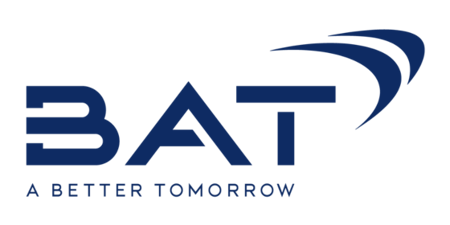
Industry:Manufacturing
Region:Asia Pacific & Japan
Client:British American Tobacco (BAT)
How BAT Uses UiPath’s Software Robots to Produce Quickly and With Quality

79
Number of software robots BAT has worked with over 4 years
> 230,000
Total labor-hours saved through automation
0
Number of errors since RPA was implemented
Client Overview
British American Tobacco (BAT) is not only a leading manufacturer of tobacco and nicotine products. It has recently been formulating new items that offer adult smokers less risky alternatives. Founded in 1902, the British multinational company has operations in 180 markets around the world.
The mission is to go “beyond nicotine”, to not only create products which are less harmful and risky, but also those that are completely non-combustible. The long-term vision—organization wide digitalization.
Armed with scientific research and cutting-edge technology, BAT is on a transformation path. Striving to increase efficiency while ensuring quality control across its facilities, BAT is a firm believer in automation. It has worked with 79 live software robots for over 4 years now.
From recording leaf stock acquisitions, to updating cigarette recipes and the cost of the materials used, the tobacco company believes in the power of digital transformation to enhance work processes as well as the employee experience.
This has freed up the time of BAT employees, allowing them to focus on higher value activities, increasing production and costing accuracy, and reducing energy usage—preventing any possible delays that could occur.
A range of digital solutions support the streamlining of BAT’s work processes which are standardized in its 44 factories across the globe, including its Malaysian factory. These solutions are managed across multiple SAP systems to enable efficient, collaborative, and streamlined work processes.
BAT partnered with UiPath to automate these global processes running across SAP systems, enhancing accuracy, safety, security, and governance.
This realization also comes from having a mature Automation Center of Excellence that deals with the technologies, and a Business Optimization Center that specializes in all processes across the business.
BAT is convinced, after years of working with robots, that robotic process automation (RPA) can simplify and manage a lot of our paperwork.
Keng Thoe Chan · Head of Automation Platform, Digital Business Solution, BAT
The 3R system—robot to robot to robot
When BAT management first noticed that their cigarette manufacturing activities were delayed at times and their financial transactions were not always recorded accurately, they immediately turned to automation to resolve the issues.
Enter the 3R system, the most recent and impressive UiPath automation adoption for BAT, which stands for Robot to Robot to Robot. True to its name, three different robots work both independently and hand-in-hand to automate different processes across operations and production facilities. They include:
Robot to handle leaf stock acquisition
Robot to update the cigarette recipes and cost of the materials used
Robot to transfer data to the Bill of Materials (BOM)
The third robot, which deals with BOM data, was developed with the aim to transfer the recipe and cost of materials used in the SAP system more accurately, especially when changes were made.
However, it was not able to carry out all the required tasks in time due to technical inefficiencies. For instance, not all of the ingredients and details on product costing were consistently updated in SAP.
This prompted the product costing team to figure out a way to implement another automation—the second robot to assist in appropriately updating and costing individual products—within the same product costing SAP. Handled by a team in Kuala Lumpur, they ensured the robots could automate and speed up the rule-based action of costing materials according to reports.
Later, the first robot was introduced within a separate SAP team called Global Leaf Pool (GLP). It was developed to manage and keep records of tobacco leaf material, the main ingredient in cigarettes. This dedicated GLP system and team in the United Kingdom ensures all tobacco leaves acquired from farmers are accounted for.
Although the robots are managed by individual teams globally, the activities are all carried out on a shared cloud platform. A rather complex process, BAT took one year to fully develop the shared system, as the governance of these robots is more than simply building and deploying code.
“The three robots ultimately fulfill different parts of the financial recording process that can be automated in SAP. If the robot is not properly processing a specific task, a developer will have to change the specification and update the code,” said Carmen-Maria Zaiu, RPA Lead at BAT.
As BAT is a publicly listed company on the New York Stock Exchange and London Stock Exchange, it is also required to abide by the Sarbanes–Oxley Act, which is a United States federal law to prevent corporate fraud, misappropriation of money, and wrong reporting of financial statements.
Hence, together with robots, BAT incorporates other software tools to improve governance.
We use project management and software versioning tools to move codes in a secure and controlled way through three environments—development, acceptance (testing), and production. We also integrated the Privileged Access Manager into the process to ensure all the robot’s credentials are secured and monitored when accessing BAT’s data and resources.
Adrian Yeow Song Yew · RPA Platform and Product Specialist, BAT
Benefits: accuracy, time and cost savings
These efforts have spurred accurate finance recording, stock management, and saved time for individual workers and teams at BAT. Unlike robots, humans are unable to monitor procedures 24/7, which was a major problem the company was facing.
“With RPA, all transactions can be recorded accurately and efficiently, especially during periods of high-volume activity and peak workload,” said Zaiu.
In the scenario when the volume of orders is high, all BAT has to do is notify the automation team to add more licenses and the UiPath robots will finish the work in time. This also saves costs for the business as it doesn’t have to hire more employees.
Overall, the three robots have automated the work of about 10 employees. If one employee does 40 hours of work a week, this translates to three robots covering 400 labor-hours of work a week.
With RPA, a worker who used to carry out a certain repetitive activity in operations or production would no longer have to do this, saving time for the person and their team as a whole.
Carmen-Maria Zaiu · RPA Lead, BAT
How to make automation work for the business
In pursuing automation, BAT has discovered that conducting constant checks with its employees—on all requirements, testing, and acceptance—is crucial to ensure efficient and effective robot management. Similarly, documenting the entire automation process in detail is also important.
This helps in anticipating possible errors, including unlikely ones, when deploying future robots. Analytical tools are used for reporting as well as the use of various software for prepping and analyzing data have been effective in addressing this challenge.
While the benefits of automation are clear, not everyone is convinced. BAT’s management is usually delighted to have new automation projects, but there are mixed feelings among employees. Some are happy for greater work efficiency, while others are worried that robots could replace them.
However, once the robots are deployed, people are generally more welcoming as they can see the tangible benefits. “Upon deployment, the people on the ground are better able to understand the benefits of the robots as they can witness first-hand how quickly and accurately it can be done,” said Zaiu.
Creating automation that is getting all the benefits of RPA at each step of the process is what we think differentiates us from the rest.
Carmen-Maria Zaiu · RPA Lead, BAT
Related case studies
Ready for your own case study?
Speak to our team of knowledgeable experts and learn how you can benefit from agentic automation.





